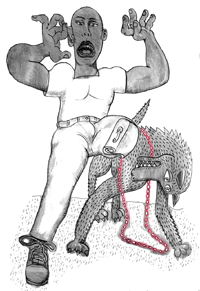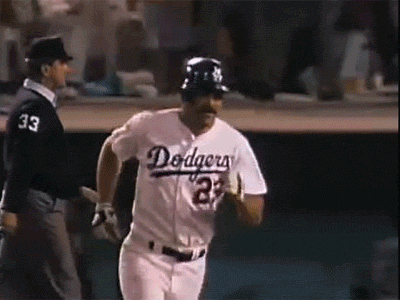Pain Culture in Baseball: A Self-Fulfilling Prophecy?
“Coach, my arm reallllly hurts”
When a player comes to you talking about being in pain, as a coach, you are immediately thrust into a position of responsibility and confronted with some difficult decisions. Do you pull the player out of the game? Switch them to a different position? Keep them in to win the championship?
Obviously there are a lot of variables that need to be taken into account and no cure-all blanket answer exists. It is not as simple as ‘I always take the player out’ or ‘we need to win this game.’ Our opinion is that we need to breakdown and analyze the situation as much as possible in order to make an informed, case-by-case decision. We believe that this begins with an understanding of what the player is communicating to you.
What does it mean when a player tells you that they are in pain? And how can understanding pain better guide the health and safety of our players long term development?
Essentially, we need to find out what they are really communicating when they come to you saying “my arm hurts’
Pain Science
Insert pain science, a rather complex topic. Understanding the concept of pain has been the focus of scientific inquiry for many years, and more recently brought into the world of contemporary manual therapy through groups like the Neuro Orthopaedic Institute (NOI). We used to think that damaging our tissues, like cutting a finger, triggered pain receptors to send a pain signal to our brain. What we call a bottoms-up approach. What is generally accepted now, however, is not so clear cut.
Let’s begin with a definition. Pain is an unpleasant multifactorial and complex sensory or emotional experience associated with actual or potential tissue damage. It is a DECISION made by our brains. (IASP)
Throughout our body we have millions of special sensory receptors called nociceptors that transmit information about potential danger (called nociception) (IASP). The distinction here is that these receptors do not transmit a painful signal, just potential danger or threat. This information makes its way to the brain for deeper interpretation of its meaning, drawing from environmental context, previous experience, emotions, and future intentions. If the brain concludes that, yes, we are in danger, it rings the pain alarm system to motivate a change or movement to reduce the potential for more damage. (Dubin 2010)
Where this gets interesting is that with any nocicpetive input the brain must make a decision to trigger the alarm system or not.
The underlying motivation for all human being decision-making is survival, and therefore it should be no surprise that we can find examples whereby experiencing pain can actually get in the way of staying alive. An extreme scenario would be a wounded soldier on the battlefield, running for miles to escape the capture of an enemy. Or a car crash victim, with a broken leg and concussion, fighting to get out of their car before it bursts into flames. In both situations, these people may not experience pain until they were out of the immediate life threatening danger.
Do you think that Donaldson was feeling any pain as he was rounding 3rd base attempting to punch a ticket to the ALCS?
On the flip side, we can experience pain without any real tissue damage or pathology. The brain must consider multiple inputs, from the emotion processing amygdala to memory centered hippocampus, to make a decision on the overall context of the information. Have you ever noticed an increase in pain after spending a day in a stressful environment? How about the absence of pain while on a relaxing vacation? Pain can be triggered or enhanced based on previous experience, social context, and environment. Even thought processes can be powerful enough to maintain a pain state. (Price 2000)

Phantom limb pain
Clinically, there are many examples of situations where there is no tissue damage, yet we still feel pain. Phantom limb pain is a frustratingly common disorder that showcases this phenomena. Although a limb may no longer be attached the body, the part of the brain that senses the area remains, and it can be trigger by activation of nearby neural activity. This can create intense and vivid pain in the area where the limb used to be. Another example is a condition called allodynia, where a normally non-painful stimulus like light touch creates a painful experience.
Key Point: Nociception is neither sufficient or necessary for pain.
Pain and the Sporting World
Now let’s apply some these concepts to the sporting world. There are many examples in sports history where athletes played an entire game without pain, only to find out afterwards that they had a broken bone or torn muscle. There are legendary tales passed on through generations where players compete in a crucial playoff game, even though they would’ve been diagnosed as ‘injured’. Think about Kirk Gibson’s heroic game winning HR in 1988. Do you think he was feeling any pain while fist pumping around the bases? What about Bob Gibson throwing to two batters in 1967 with a broken leg?
As mentioned earlier, our brain is constantly taking in all of the possible information and answering the following question; are we currently in danger?
Now let’s examine the current culture in baseball. The concepts of throwing and shoulder or elbow pain are married. In today’s game, it is almost considered a right of passage to have arm pain if you throw hard. How many times have you heard a player boastingly admit to his friend “my arm hurts so much I’m gonna pop 4 Ibuprofens.” We even see players who think getting Tommy John surgery is just an initiation to the cheddar pumping community. We get tattoos of laces on our elbow. It’s not a big deal. It’s part of the game. It’s cool.
Players are expecting to have pain because it’s the status quo. If we are developing a culture in which pain is to be expected, and we know that pain is an interpretation of context and meaning without the requirement of tissue damage or nociception, then is it possible that players are incepting themselves into a pain state. Are some players experiencing pain without any tissue damage? Is it a self-fulfilling prophecy?

An instance where maybe pain =/= injury
Again, the most important thing to understand about this, is that pain is not synonymous with tissue damage to our joints, bones, ligaments or muscles. Hurt does not equal harm. There is a lot of research that supports this notion, even in the baseball world. In 2013, Lesniak et al published an article demonstrating this concept. From 2001-2011 they took preseason MRIs of 21 different MLB pitchers who had not had a stint on the disabled list in the previous 2 seasons.
They found that;
- 11 of the 21 pitchers had a rotator cuff tear
- 9 had a SLAP tear (superior labrum anterior and posterior)
- 13 had anterior or posterior labral tears.
These players had MRI diagnosed pathology, but were still able to function. Had doctors been provided no history on the player and only these MRI findings, would they have concluded that they needed surgery? To be placed on the DL? Would the doctor have guessed that these players would have pain with throwing?
If we can separate function from tissue pathology in the shoulder is it completely unreasonable to expect some similarity in the elbow?
Things are not as simple and straightforward as we would like them to be.
So, when our players tell us that they are in pain, we should not automatically think “torn labrum or UCL sprain”. We need to consider much more of the context and meaning of the information.

You think that Gibson was feeling any pain here?
Things to Consider
As you can begin to tell, having an understanding of some basic pain science concepts opens up a lot of potential conversations and thought processes regarding the opening scenario. Let’s circle back and take a look at a couple of these ideas.
Language:
When a player tells you that his arm hurts, what is he trying to communicate? Does it mean that he is in pain, uncomfortable, fatigued, has dead arm or something else? We must educate and be educated on defining the difference between all of these states. Discomfort is not the same thing as a sharp pain, which is different than numbness and tingling, and all must be handled differently. The better the communication, the more informed the decision that we can make.
Game context:
What is the context within the game? Have they just given up 6 runs in 2 innings? Are they having a tough time at the plate? Maybe the last time they faced this team they played poorly. If they were playing in the field earlier that game, did they make a crucial mistake or error? All of these game related issues should be considered.
Emotional make up:
How does this player handle themselves emotionally? Are they the type of player that maintains a positive attitude when they are in the middle of a slump? Do they tend to get emotional after giving up a few unearned runs? Are there any stress-related problems outside of the baseball world? These are the types of players that are more likely to have heightened sensitivity and potentially pain without any harm.
Previous history of pain:
Does this player have a history of being in pain? Are they always sore, hurt, or complaining of pain? Sometimes if our body assumes a state of pain after a long enough period of time it becomes very good at experiencing pain. Previous pain breeds more pain. How many times have you seen a kid who hurt his arm, let’s say a tendonopathy, and a year later is still showing signs of discomfort or apprehension when throwing at 90% + of their max velocity. As soon as they hit a certain threshold of intent, they notice that their elbow gets sore and stop throwing in fear of injury. Knowing what we now know, does this necessarily mean that they have tissue injury? Is it possible that their elbow pain is a result of their brain’s interpretation of the danger associated with throwing at 90%+ velocity?
How do we Break the Cycle? Thoughts for the Future
Providing a detailed explanation about how to overcome these issues is worth another post, so we will keep it quite simple here.
Education:
Above all else, education on these concepts is the number one factor in breaking the pain prophecy cycle. Informing the players, coaches, and parents on the difference between pain and pathology, demystifying the idea that every pitcher will succumb to pain or injury, and altering how we communicate about pain in general is paramount to conquering this issue. What we want to get away from is quotes like ‘no pain, no gain’ and move towards an attitude of ‘hurt does not equal harm’.
Graded exposure:
The NOI group recommends slowly pacing yourself passed previously painful movements – what they call graded exposure. This requires finding a baseline where pain kicks in, proceeding a planned progression, being patient as our tolerance increases, and most importantly to not freak out if a flare up occurs. This process sounds very similar to progressive overload, and that’s because it is. But in this case we are dealing with the psychosocial aspects as well. Understanding these pain science concepts does not mean you’ll be throwing pain free overnight. It requires persistence.
Assessing and intervening on the psycho-sociological component:
This goes hand in hand with the previous two, but just adds awareness to the concepts of mental toughness, assessing players attitudes, coping strategies and outside stressors. Essentially we want to be aware of the bigger psychosocial picture of our players, especially the ones that seem to be in pain more often. As mentioned previously, our emotional state can play a big role in determining the appearance and intensity of a painful experience. Becoming more in tune with the psycho-sociological makeup of our players, and attempting to slowly intervene appropriately can go a long way.
Takeaways
The previous examples are just a short list of things to consider when a player comes to you complaining of pain. The key take away here is to understand that we cannot immediately jump to a conclusion that the player has sustained injury. Coaches must take into account all of the contextual information, from the game specifics to the players emotional intelligence, in order to make an informed decision on game day.
Ultimately, erring on the side caution is the most responsible choice. Baseball coaches, by and large, are not pain scientists, physicians, or therapists. Their role in this situation is to gather all of the relevant information, make an informed decision on immediate action, and if necessary, refer them to a qualified health care practitioner. Reading this blog post and a book on pain science does not qualify coaches to take on the role of doctor. If a player presents with acute or chronic pain, first distinguish whether it is discomfort or not, stop the activity and record the facts. Anything that you might believe is relevant. Get on board with the parents, provide your interpretation of what happened, and refer them to a qualified and pain science informed health care practitioner. Over time, education on these topics will slowly change your teams pain culture, and you will be faced with less frequent and more clear cases like the opening scenario.
If you have any questions, let us know below in the comments.
Dr. Stephen Osterer
